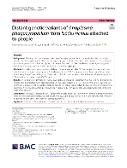Distant genetic variants of Anaplasma phagocytophilum from Ixodes ricinus attached to people

Autor
Lesiczka, Paulina Maria
Hönig, Václav
Modrý, David
Zurek, Ludek
Datum vydání
2023Publikováno v
Parasites & VectorsRočník / Číslo vydání
16 (1)ISBN / ISSN
ISSN: 1756-3305Metadata
Zobrazit celý záznamKolekce
Tato publikace má vydavatelskou verzi s DOI 10.1186/s13071-023-05654-y
Abstrakt
Background: Although the tick-borne pathogen Anaplasma phagocytophilum is currently described as a single species, studies using genetic markers can distinguish groups of variants associated with different hosts, pathogenicity, zoonotic potential and biotic and geographic niches. The objective of our study was to investigate the genetic diversity of A. phagocytophilum and Ixodes ricinus ticks attached to people. Methods: In collaboration with a commercial diagnostic company, a total of 52 DNA samples were obtained from ticks that tested positive for A. phagocytophilum by quantitative PCR. The genetic profile of each sample was determined using the groEL and ankA genes. Identification of the tick species was confirmed by partial sequencing of the COI subunit and a portion of the TROSPA gene. Results: All 52 ticks were identified as I. ricinus. Two protocols of nested PCR amplifying 1293- and 407-bp fragments of groEL of A. phagocytophilum yielded amplicons of the expected size for all 52 samples. Among all sequences, we identified 10 unique genetic variants of groEL belonging to ecotype I and ecotype II. The analysis targeting ankA was successful in 46 of 52 ticks. Among all sequences, we identified 21 unique genetic variants phylogenetically belonging to three clusters. Conclusions: Our results indicate that ticks attached to people harbor distant genetic variants of A. phagocytophilum, some of which are not recognized as zoonotic. Further studies are needed to determine the risk of human infection by genetic variants other than those designated as zoonotic. Graphical Abstract: [Figure not available: see fulltext.].
Klíčová slova
Anaplasma phagocytophilum, Anaplasmosis, Genetic diversity, Infectious diseases, Ixodes ricinus
Trvalý odkaz
https://hdl.handle.net/20.500.14178/1830Licence
Licence pro užití plného textu výsledku: Creative Commons Uveďte původ 4.0 International







